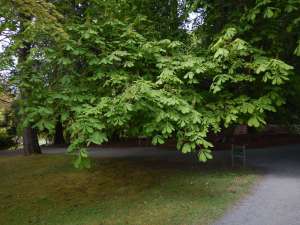Curious about how to ID a Horse-chestnut no matter what the season?

Here’s today’s fun fact…
Chestnuts and Horse-chestnuts look very similar. But they’re not even related. Chestnuts are kin to beech trees. Horse-Chestnuts are part of the soapberry family. (Go figure!)
They’re both grown as boulevard trees around Victoria to great effect.

Wouldn’t it be romantic to collect chestnuts for roasting on an open fire – – you know, like the song?
For sure!
But here’s the catch…
The Horse-chestnuts are poisonous.
It’s essential to collect the right nuts.

I thought they were easy to ID in the spring. I’d see some trees with pink blooms & others with white flowers.
Simple, right?
Turns out, each species has varieties with pink blooms & varieties with white.
So much for that theory.
Even if that had been a handy trick, there’s still another catch. The blossoms don’t last very long & then I have to rely on the memory of which was which.
(Not a great guarantee).

It’s recently come to my attention that there’s a simple way to ID the Horse-chestnut at any time of year: Look closely at the branches. Along the branch, just beside where the leaf joins the twig, is a little U-shaped mark of a horseshoe — nails & all.
How cute is that?? A horseshoe mark on a Horse-chestnut.

Today’s fun fact comes to you via Jeff, the woodland gardener of Royal Roads University at Hatley Park National Historic Site.
-30-






